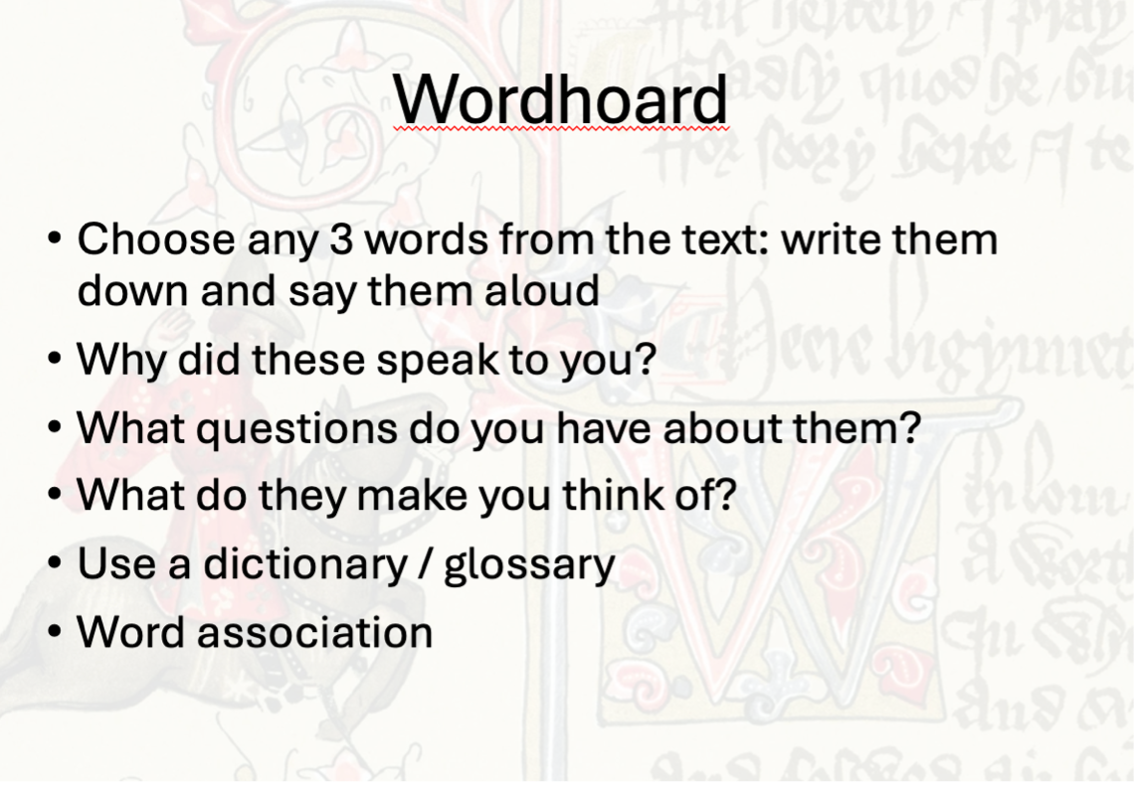‘Creativity in the Classroom’ workshop: GuMM at ‘Chaucer our Contemporary’ event 4/10/25
Write up by Laura Varnam
On the 4th of October, the Guild of Medievalist Makers was represented at ‘Chaucer our Contemporary: Teaching, Reading, and Rewriting Medieval Literature Today’, a one day colloquium for English Literature academics and school teachers, organised in conjunction with the Institute of English Studies and The English Association, with sponsorship from Queen Mary University of London, Royal Holloway, and University College London.
Guild co-founder Laura Varnam and Guild member Catherine Clarke (author of the newly published A History of England in 25 Poems and director of the Centre for the History of People, Place, and Community at the IHR) co-ran a workshop , sponsored by the Guild, on ‘Creative work with Chaucer in the Classroom: Methods and Payoffs’, exploring a variety of ways in which teachers of Chaucer in schools might use creative methods for engaging students with texts such as The Merchant’s Tale (currently on the A level syllabus in the UK.)
In this blogpost, Laura shares the framework and methods that she & Catherine developed for the workshop.
Catherine and Laura began by exploring why creative approaches might have benefits in the classroom, noting that modern students may find Chaucer’s Middle English language and distant historical period challenging and a barrier to engagement. They discussed creativity as a way of inspiring confidence in students by giving them license to ‘play’ with the primary texts without the pressure of formal assessment. This encourages fun and enjoyment, engages students with a variety of learning styles (visual, kinetic etc), offers new ways into the medieval language, and encourages new modes of empathy and connection. As Diane Ackerman writes in Deep Play (1999), ‘the world of play favors exuberance, license, abandon. Shenanigans are allowed, strategies can be tried, selves can be revised.’ The provisionality and dynamism of play enables creative thinking and dispenses with fears of failure or pursuit of narrowly defined ‘intellectual success’ (which can be a particular feature of often rigid assessment objectives for students at A level).
Laura and Catherine discussed a variety of examples of modern Chaucerian adaptations that teachers might share with their students, including Patience Agbabi’s Telling Tales. Agbabi described her own fears of ‘taking on the grandfather of English literature’ when she began her project, confessing that the ‘first six months were hell. I was too reverent, scared to put a foot out of line’ but when she allowed creativity to take over, the project took flight. ‘Whenever I got stuck I reread the original text and imagined Chaucer winking at me, saying, go girl.’ Chaucer himself is, of course, the master of retelling, updating, and subverting old tales, so approaching his work through a similar mode can also teach students about his methods in a practical way. As he states in the Parliament of Fowls, ‘out of olde feldes, as men seith, / cometh al this newe corn fro yeer to yere’ (22-23).
Catherine and Laura then described three different activities that teachers could use: 1. Wordhoard task, 2. Re-Voicings activity, and 3. Six-Word adaptation task (as devised by Guild co-founder Kristen Haas Curtis.)
Workshop Activities
1. The Wordhoard task: this task enables students to have fun with language while exploring meaning, etymology, and links to present day English. Choosing their own words gives them ownership over the text.
2. Re-Voicings activity: inspired by retellings such as Zadie Smith’s Wife of Willesden, Agbabi’s Telling Tales, and other medievalist revoicings (such as Laura’s feminist adaptation of Beowulf), this activity focuses on switching perspectives in a story, encouraging emotional empathy, and reimagining the story in the students’ own language or dialect. You can also play a version of the parlour game Consequences with this activity which came be great fun in the classroom.
3. Six-Word adaptation task. This task was devised by Kristen Haas Curtis and you can find her instructions here. It encourages students to simplify the text they are working on into six words and it enables expansion and development by bringing in a visual element. This is also empowering for students who are visual learners and keen artists.
There are, of course, all sorts of other activities that you might do in a creative classroom! You could create social media accounts for Chaucer’s characters. Play with black out poetry. Flip the genre of the story and see what happens. And many more! (And please do get in touch with us via email or on social media if you have suggestions or activities that have worked for you!)
During the colloquium, Catherine also facilitated a wonderful conversation between award-winning poet Caroline Bergvall and Guild co-founder Laura, exploring their methods and approaches to adapting and updating Middle English texts. Caroline read from her books Meddle English and Alisoun Sings, Laura discussed her poetry inspired by medieval mystic Margery Kempe, and the conversation ranged widely across modern responses to medieval texts (including the publications associated with the Refugee Tales project), the role of poetry & empathy in public history (inspired by Catherine’s approach in A History of England in 25 Poems), and the urgent importance of creativity in the age of AI. (A recording of this conversation will be linked here when it becomes available).
Laura would like to thank Catherine, Caroline, and the organiser of the day, Alfred Hiatt, for the opportunity to represent the Guild and for all the brilliant A level teachers who shared their expertise and enthusiasm for Chaucer. It was a super day!




